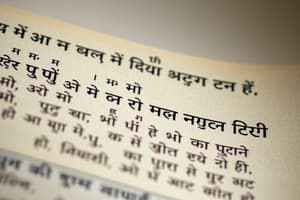Podcast
Questions and Answers
What is the primary script used to write Sanskrit?
What is the primary script used to write Sanskrit?
- Brahmi
- Tamil
- Devanagari (correct)
- Latin
Which of the following is included in Vedic literature?
Which of the following is included in Vedic literature?
- Ramayana
- Rigveda (correct)
- Bhagavad Gita
- Mahabharata
How many noun cases are present in Sanskrit?
How many noun cases are present in Sanskrit?
- 5
- 7
- 8 (correct)
- 10
Which of the following best describes the grammar of Sanskrit?
Which of the following best describes the grammar of Sanskrit?
What is one of the modern contexts of Sanskrit usage?
What is one of the modern contexts of Sanskrit usage?
Which of the following is a characteristic of Sanskrit phonetics?
Which of the following is a characteristic of Sanskrit phonetics?
Which ancient Indian playwright's works are included in classical literature?
Which ancient Indian playwright's works are included in classical literature?
What is a modern approach to learning Sanskrit?
What is a modern approach to learning Sanskrit?
Flashcards are hidden until you start studying
Study Notes
Overview of Sanskrit
- Language Family: Indo-European, specifically part of the Indo-Aryan branch.
- Script: Primarily written in Devanagari, though other scripts like Brahmi and Tamil are also used.
- Historical Significance: One of the oldest known languages, with roots traceable back to at least 1500 BCE.
Characteristics
- Phonetics: Rich phonetic structure with a wide range of sounds; includes vowels (13) and consonants (33).
- Grammar:
- Highly inflected language with complex morphology.
- Noun cases: 8 (nominative, accusative, instrumental, dative, ablative, genitive, locative, vocative).
- Three genders: masculine, feminine, neuter.
- Verb conjugations based on tense, mood, voice, number, and person.
Literature and Texts
- Vedic Literature: Includes the Vedas (Rigveda, Samaveda, Yajurveda, Atharvaveda) which are sacred texts of Hinduism.
- Epic Texts:
- Mahabharata: One of the longest epics, includes the Bhagavad Gita.
- Ramayana: Epic narrative of the prince Rama.
- Classical Literature: Includes dramas, poetry, and philosophical texts like the works of Kalidasa and Bhasa.
Usage
- Historical Context: Used in religious, scholarly, and literary contexts in ancient and medieval India.
- Modern Context:
- Recognized as a classical language of India; limited use in daily communication.
- Sanskrit studies are pursued in academia and religious institutions.
Influence
- Cultural Impact: Source of many words in modern Indian languages and has influenced Southeast Asian languages and cultures.
- Philosophy and Religion: Key language for Hindu, Buddhist, and Jain texts, contributing to philosophical discourse.
Learning Sanskrit
- Approaches: Can be learned through traditional methods (grammar, chanting) and modern methodologies (app-based learning).
- Resources: Textbooks, online courses, and language communities available for learners.
Preservation Efforts
- Institutions: Various universities and organizations work towards the revival and promotion of Sanskrit.
- Publications: Ongoing efforts to publish new translations and interpretations of classical texts.
Overview of Sanskrit
- Language belongs to the Indo-European family, specifically the Indo-Aryan branch.
- Primarily written in the Devanagari script, but also appears in Brahmi and Tamil scripts.
- One of the oldest languages, dating back to at least 1500 BCE.
Characteristics
- Rich phonetic structure with 13 vowels and 33 consonants, allowing for a wide range of sounds.
- Highly inflected with complex morphology, featuring 8 noun cases: nominative, accusative, instrumental, dative, ablative, genitive, locative, vocative.
- Three grammatical genders: masculine, feminine, and neuter.
- Verbs conjugate according to tense, mood, voice, number, and person.
Literature and Texts
- Vedic literature comprises the foundational texts of Hinduism, including the four Vedas: Rigveda, Samaveda, Yajurveda, Atharvaveda.
- Epic literature includes the Mahabharata, one of the longest epics featuring the Bhagavad Gita, and the Ramayana, which narrates the story of Prince Rama.
- Classical literature includes diverse genres such as dramas and poetry, with notable contributions from authors like Kalidasa and Bhasa.
Usage
- Historically used in religious, scholarly, and literary contexts throughout ancient and medieval India.
- In modern times, recognized as a classical language of India, with limited usage in daily life.
- Sanskrit studies thrive in academic institutions and religious organizations.
Influence
- Significant cultural impact, serving as a source of vocabulary for many modern Indian languages and influencing Southeast Asian languages and cultures.
- Essential for Hindu, Buddhist, and Jain philosophies, contributing to extensive philosophical discourse.
Learning Sanskrit
- Learning methods include traditional approaches focused on grammar and chanting, alongside modern techniques like app-based learning.
- Resources for learners consist of textbooks, online courses, and supportive language communities.
Preservation Efforts
- Numerous universities and organizations are involved in reviving and promoting the use of Sanskrit.
- Continuous efforts to publish new translations and interpretations of classical Sanskrit texts.
Studying That Suits You
Use AI to generate personalized quizzes and flashcards to suit your learning preferences.




